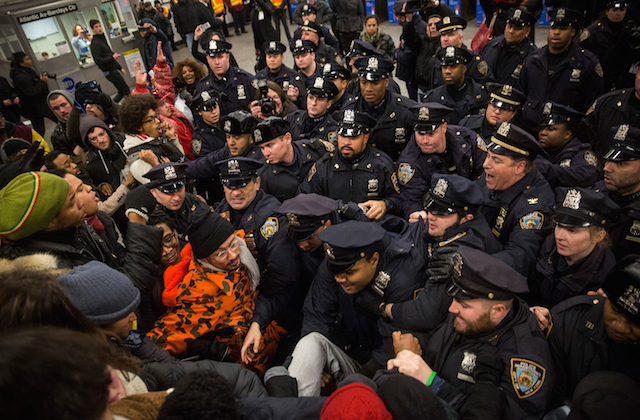More than three decades ago, the Supreme Court confronted whether the police violate a person’s constitutional rights when they use chokeholds in routine encounters with the public–precisely the dynamic we recently witnessed in the killing of Eric Garner. A lower court had banned their casual use, but in Los Angeles v. Lyons (1983) a five-four majority of the Court overturned that ruling. In effect, they allowed the police to continue using life-threatening chokeholds even against persons who pose no threat of violence.
A blistering dissent came from Justice Thurgood Marshall, the first African-American to sit on the nation’s highest court. Marshall aimed much of his ire at the majority’s tortured legal reasoning, which held that even if the commonplace application of chokeholds raised constitutional issues, plaintiff Adolph Lyons–choked unconscious seemingly for driving while black–was not the right person to sue, since he couldn’t be sure he would be choked again.
Before wading into the arcane legal fight, however, Marshall emphasized the human dimension of what happened:
When Lyons regained consciousness, he was lying face down on the ground, choking, gasping for air, and spitting up blood and dirt. He had urinated and defecated. He was issued a traffic citation and released.
Lyons’ extreme physical reaction to being choked–loss of consciousness and bowel control–were not exceptional, Marshall carefully showed, but typical of the harrowing physiological consequences that come with choking persons into submission.
The majority ignored this human reality. Likewise, still today most of us don’t understand fully what chokeholds do. Listen as Marshall condemns this lethal violence–in a way that, because of what the Supreme Court decided that day, foreshadowed Eric Garner’s needless killing:
Although the City instructs its officers that use of a chokehold does not constitute deadly force, since 1975 no less than 16 persons have died following the use of a chokehold by an LAPD police officer. Twelve have been Negro males.
[…]
It is undisputed that chokeholds pose a high and unpredictable risk of serious injury or death. Chokeholds are intended to bring a subject under control by causing pain and rendering him unconscious. Depending on the position of the officer’s arm and the force applied, the victim’s voluntary or involuntary reaction, and his state of health, an officer may inadvertently crush the victim’s larynx, trachea, or thyroid. The result may be death caused by either cardiac arrest or asphyxiation. An LAPD officer described the reaction of a person to being choked as "do[ing] the chicken," in reference apparently to the reactions of a chicken when its neck is wrung. The victim experiences extreme pain. His face turns blue as he is deprived of oxygen, he goes into spasmodic convulsions, his eyes roll back, his body wriggles, his feet kick up and down, and his arms move about wildly.
The LAPD does not distinguish between felony and misdemeanor suspects. Moreover, the officers are taught to maintain the chokehold until the suspect goes limp, despite substantial evidence that the application of a chokehold invariably induces a "flight or flee" syndrome, producing an involuntary struggle by the victim which can easily be misinterpreted by the officer as willful resistance that must be overcome by prolonging the chokehold and increasing the force applied. In addition, officers are instructed that the chokeholds can be safely deployed for up to three or four minutes. Robert Jarvis, the City’s expert who has taught at the Los Angeles Police Academy for the past [12] years, admitted that officers are never told that the bar-arm control can cause death if applied for just two seconds.
More than three decades before the New York police choked Eric Garner to death after confronting him, supposedly for peddling loose cigarettes, Justice Marshall tried to leverage his place on the Supreme Court to educate the whole country about the violent, life-wasting reality of routine chokeholds. How much longer and how many more deaths until the nation listens?
Ian Haney Lopez teaches constitutional law at UC Berkeley. Follow him at @ianhaneylopez and ianhaneylopez.com
